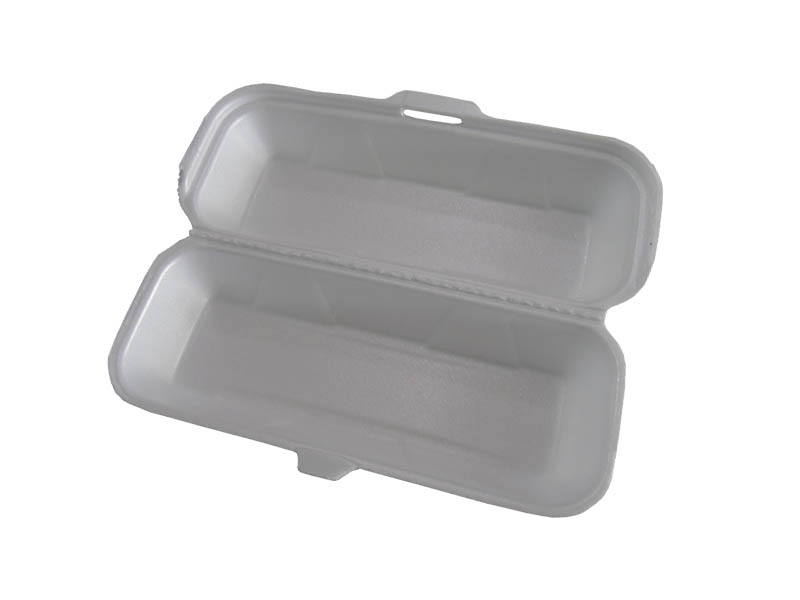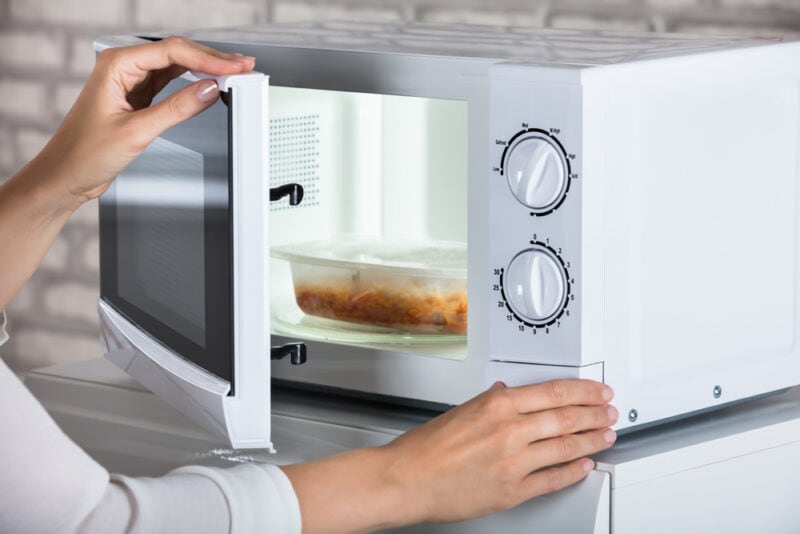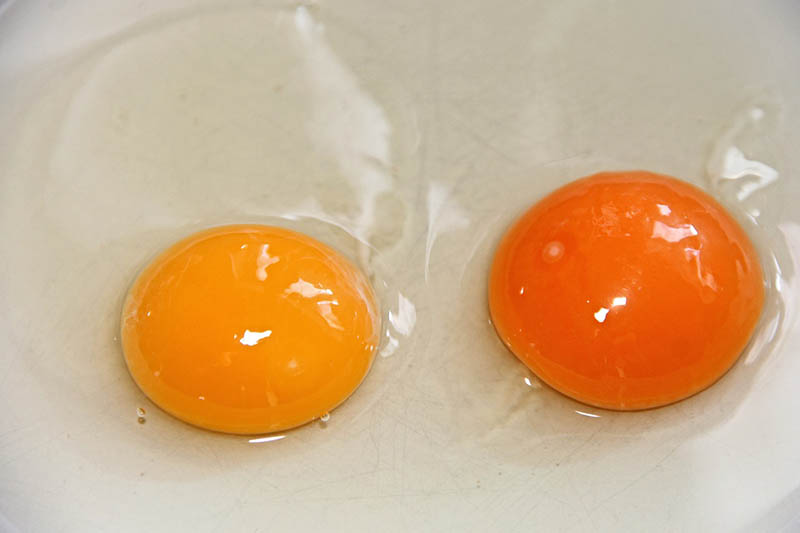Can You Put Styrofoam in the Microwave? Risks & Safety Tips
-
- Last updated:

It’s hard to imagine our lives without microwaves. When we’re late to work/school, the oven swoops in to save the day. It only takes 1–2 minutes to heat food and have it ready on the table. But what about the container, though? Is it safe to put Styrofoam inside the oven? For the most part, the answer is no. You can only use it if the container is approved by the FDA.
However, if the EPS/XPS product doesn’t come with a label that says “microwave-friendly”, you should NOT put it inside an oven. So, what kind of a risk does using Styrofoam involve? What about other types of plastic? How do you find the right container? Read on to learn the answers!

What Is Styrofoam? Breaking It Down

Styrofoam is a go-to insulation material for construction companies in the US and Canada.1 Also known as the “Blue Board”, Styrofoam is an XPS (extruded polystyrene foam) product made by DuPont. Many houses around the country have it installed inside the walls, floors, and roofs. Here’s the important part: this term is often wrongfully used to describe a different type of foam, EPS (expanded polystyrene foam).
And this “false Styrofoam” is used to make disposable cups and plates, food containers, and egg cartons. It’s a cheap, low-maintenance, easy-to-build material that can keep our drinks and foods warm. That’s exactly why it’s so popular. On the downside, containers made from polystyrene are bad news for the environment (they take forever to break down) and are slowly being replaced.2
So, Can You Use Styrofoam Containers in an Oven?
On a large scale, polystyrene is not a hazardous material. But, recent studies have shown that styrene,3 a chemical compound found in many Styrofoam containers, can potentially cause cancer.4 Now, in normal circumstances, you, most likely, won’t be exposed to dangerous levels. However, when we put polystyrene containers in the oven (even for a minute or two), they start melting.
As a result, harmful chemicals may find their way into the food. In other cases, the plastic will crack, releasing even more carcinogens, contaminating the food, and making it leak out. This mostly applies to beverages and fat-rich foods. That said, in the States, plastic/polystyrene products are tested and regulated by the FDA. So, if they have a microwave-safe tag, that means they’re officially allowed into the oven.
HDPE, LDPE, PET, and PP: Are They Safe to Use or Not?
But wait: what about plastics other than Styrofoam? Can you put them in the oven? Well, that depends on what kind of plastic you’re dealing with. The rule of thumb is—if the plastic has below-average resistance to heat, the microwave will melt it while getting your meal ready. Again, the FDA recommends only using containers that pack an “oven-safe” tag.
So, instead of having to learn about all the different types of plastic and their chemical compounds, just look for that label. If you can’t find it, that only means one thing: keep it away from the microwave. Thankfully, there are more than enough alternatives (we’ll get to that in a moment), and they don’t cost a fortune.
Things You Should NEVER Put in a Microwave

The first thing to remember is that microwaves can’t handle aluminum foil. That’s because microwaves reflect off the surface, which could potentially cause a fire and damage the appliance. Or, at the very least, your food will have a bad taste because it won’t cook evenly. Brown paper bags, in turn, are known to emit dangerous toxins into the air; the same is true for disposable dishes and cups.
Metal is not recommended, either, as it might, quite literally, put the microwave on fire. Oh, and by the way, the “check-the-label-first” rule applies not only to plastic but to all the other materials out there. For example, ceramic, glass, and cling film are generally ok to use, but you should still make sure before you throw them into the microwave. Here’s a more detailed look at the things that don’t go well with ovens:
- Most plastic bags and containers
- Aluminum foil (reflects the radiation)
- Brown paper bags (emit hazardous fumes/catch fire)
- Disposable mugs and dishes (may release chemicals)
- Insulated or waterproof cups/boxes/bottles (covered in wax)
- Metal or steel cutlery (doesn’t absorb electromagnetic waves)
- Takeout containers (might have a metal rim)
- Spicy food (peppers—may hurt your eyes)
- Water (may burn you when superheated)
- Raw eggs (they’ll probably explode)
- Frozen protein (could spread hazardous bacteria)
- Broccoli (the oven will rob it of its nutrients)
- Uncovered pasta sauce (will get messy)

Microwave-Friendly Materials: A Quick Look
That’s quite a large list! And it might make it seem like ovens aren’t compatible with 90% of the most popular materials. Well, that’s not true. You can always use one of these materials:
- Thermoplastics
- Paper cups and plates
- Parchment paper
- Reusable food containers
- Carton containers
- Ceramic dinnerware
- Heat-resistant glassware
- Cling film or wrap
General Microwave Safety Tips
Now that we know about the materials, products, and foods that can and can’t go in a microwave, here are some more quick safety tips to follow:
- Buy a microwave oven that’s listed by a trusted, third-party testing laboratory. You don’t have to do much: just fill out the registration card (it should come with the oven) and send it back. This way, the company will be able to notify you of a recall and potentially save you from a disaster in the kitchen.
- Follow the instructions. Don’t forget to check the oven’s manual for directions. There, you’ll find instructions on how to operate the appliance. For starters, don’t ever leave the door open. Second, avoid superheating water/other liquids in a microwave. If you have to, only do that according to the recommendations.
- Check for leaks. Take a moment to thoroughly examine the device. Chances are, some of the seals, hatches, or latches are damaged or out of alignment. Pay extra attention to the door: if it’s damaged or doesn’t close properly, turn the oven off. And if the microwave keeps running while the door is open, that means it is malfunctioning.
- Next, make sure the microwave is easy to access (don’t put it too high up on the shelves) yet not within the reach of a child.
- When plugging the appliance, skip extension cords. Instead, plug the device into the outlet. This is true for all appliances that need lots of power to run.
- Don’t put bottles of baby formula in the oven. The reason: it doesn’t always heat evenly, and the formula may have hot spots that will burn the baby’s lips and tongue.
- Always open food containers slowly to avoid the heat getting in your face. Also, give it a nice stir and a “hotness test” to know it’s safe to eat.
- Finally, if you notice a fire inside the microwave, close its door and disconnect it from the outlet. Only call 911 (to get the fire department) if the fire isn’t fading away.

How Long Do Microwaves Last?
This largely depends on how often you use it and how good you are at maintenance. If you’re a thoughtful and attentive person living alone, the oven will, most likely, last for 8–10 years. More frequent use, in turn, will make it break down sooner (in 7–8 years). On the other hand, if you use it all the time and rarely check the appliance for signs of leaks, cracks, and other issues, the microwave won’t last nearly as long.
We’re talking about a significantly shorter lifespan (4–5 years). A big family that relies heavily on this appliance to heat their food should keep this in mind. On the bright side, if the oven does break down, you should be able to afford a new one. Decent-quality smaller units are available for $50–$100. Mid-size microwaves come in at around $200–$300.

Conclusion
When trying to heat yesterday’s leftovers to have a bite before leaving for an important meeting, microwave ovens are a God-sent. Still, you should be careful about what kinds of containers you use for that. Mainly, we’re talking about plastics. Now, if the container cracks, that’s not always a big deal. However, when the temperature in the oven reaches a critical level, that will make certain plastic melt.
That, in turn, may lead to dangerous chemicals leaking into the food. We’re talking about styrene, along with other hazardous compounds. Fortunately, there are quite a few alternatives, including ceramic, glass, and paper dinnerware. Besides, if the plastic container has an “oven-ready” label, the FDA says it’s safe to use.
See also: Can You Put a Plastic Bag in the Microwave? (Microwave Safety Tips)
- NFPA.Org – Microwave Oven Safety
- FDA.Gov – 5 Tips for Using Your Oven Safely
- FDA.Gov – Infant Formula: Safety Do’s and Don’ts
- NIH.Gov – Styrene Exposure And Risk Of Cancer
- FDA.Gov – Code of Federal Regulations Title 21
- Atsdr.CDC.Gov – Styrene, ToxFAQs
- UnwrappedProject.org
- Choice.com.au
- Insider.com
- NFPA.org
- https://applianceanalysts.com/how-long-microwave-lasts/
- Consumer Reports
Featured Image Credit: triocean, Shutterstock
Contents

